EVGA P55 FTW - It's Here...Pictorial Preview
by Rajinder Gill on August 10, 2009 11:07 PM EST- Posted in
- Raja's Ramblings
Sorry folks, we actually have another shameless P55 motherboard picture preview for you. I know Gary thought his ASRock article was the last of them, but EVGA released us this evening to discuss their flagship P55 (E657) FTW (For The Win) product. We know you are urging us to break rank at this point and post up some heavy overclocking benchmarks and performance comparisons against the i7 platform, but there is little chance of getting away with anything other than a few pictures to look over until the platform embargo lifts.
We are not quite sure at this point of how many users will be attracted to higher cost i5 boards given the fact that that total platform cost overlaps the cost of entry-mid level i7 offerings. However, this has not deterred any of the big players from putting together a top-end i5 package based upon a combination of features they think will reel in customers. Early pricing lists of i5 boards are putting the top-end offerings between the $200~$250 mark, this one is no different with an estimated MSRP of $250 (there will be a few sub $200 models offered as well as an NF200 'Classified' variant of the board we're previewing today).
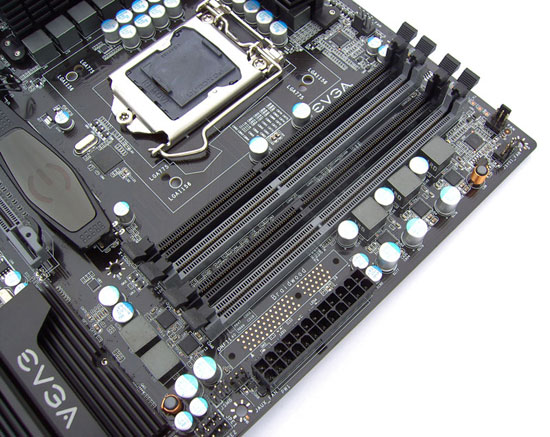
Any board following in the footsteps of the EVGA X58 Classified has a lot to live up to. Early overclocking tests on the i5 platform have revealed a similar trend to what we saw on the X58/i7 motherboards when used with sub-zero cooling, with the top-end EVGA P55 boards ahead of the competition by the slimmest of margins as we move into the final tweaking stage before full retail release.
It is not a massive gap at this point, we are talking a 3-5 BCLK difference between this board and the ‘best of the rest’ given the same hardware configuration and voltages. For the more conventional user (those using air and water cooling), our take is that you won’t find any overclocking advantage comparing one enthusiast board over another, assuming functionality is completely up to speed.
There are a number of unique hardware features that EVGA hopes will help keep their top line boards ahead of the pack when really pushed by an enthusiast. EVGA has gone the extra mile by providing onboard hardware components that make fine adjustment compensation for all major signal lines possible among other items. Team these functions with sub-zero boot-up & current limit manipulation jumpers and we begin to see that EVGA is making a full assault for the P55 overclocking crown.
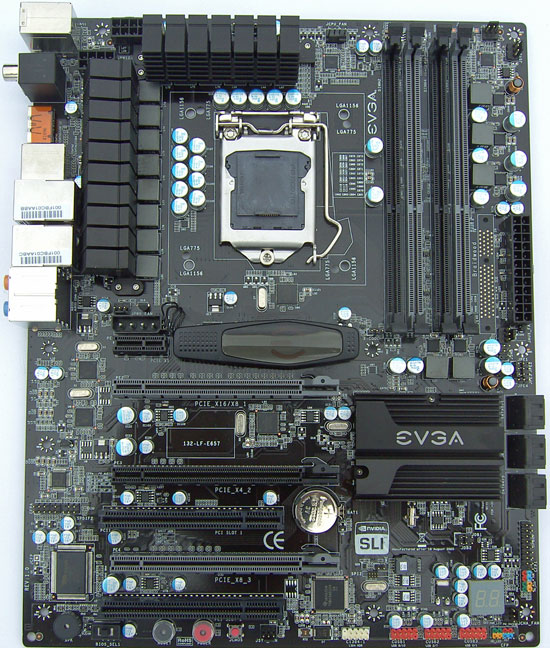
Companies such as EVGA, DFI and MSI continue with a purist approach to PWM design for all major power rails. We happen to sit with the camp that believes in the importance of fast transient response and low noise attributes first. The proof is in the pudding and we’re eager to compare several boards side by side to see if any additional overclocking headroom can be realized that supports the ‘more phases=unconditionally better’ theory.
Initial in lab tests indicates that the only thing that really matters from a user perspective is that the given PWM design is capable of pumping out the required current comfortably and cleanly. The rest comes down to heat management and ease of cooling; anything more seems to be a matter of marketing rather than real substance.
Other than costs, we cannot see a reason why it is not possible to keep a reasonable phase count by using suitably sized MOSFET’s with a decent heat sink and capable buck controller. We think it would be of more use to all concerned if companies would simply inform all of us how much current their PWM circuits can supply rather than tell us about XXX number of phases, which on its own does not tell us anything at all.
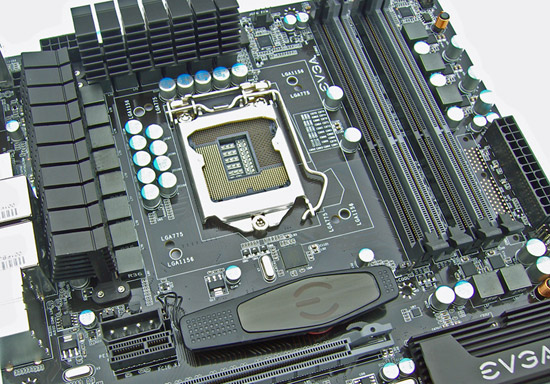
In the case of the E657 FTW, CPU power is supplied by a 600W peak current capable 12-phase supply (more than i5 will ever need). VTT and memory power is supplied by 2 and 3 phase supplies respectively, both using the same model of FET’s as used for the CPU. You’ll also notice that EVGA has added socket 775 mounting holes at a slight angle from the 1156 holes, a welcome addition for those of you with a good 775 heat sink or those of you concerned about needing new socket mounts for those trusted LN2 pots and phase change coolers.
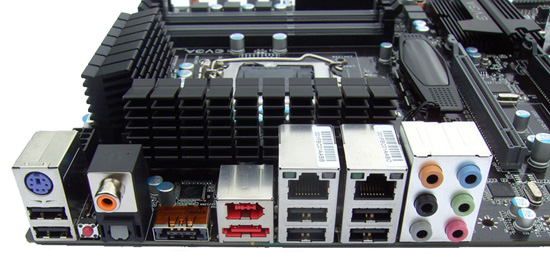
The rear panel contains 6 USB ports, PS2 keyboard port, 2 ESATA ports, 1x1394a port, dual Marvell Gigabit LAN ports and the audio panel driven by the popular Realtek ALC889 HD codec. A CMOS clear button is provided on the rear panel for ease of use when the board is mounted in a case.
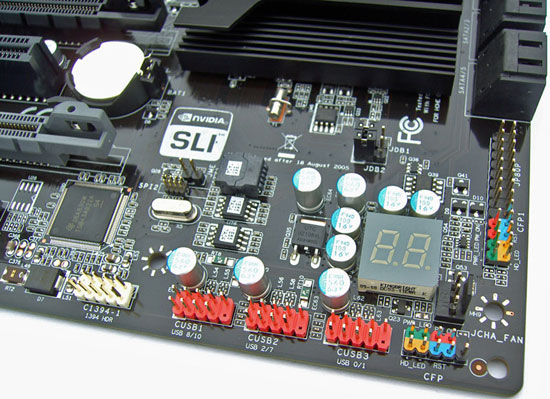
A Hex postcode display is available for debugging purposes together with an output connecter for EVGA’s OCP (overclocking panel) which helps users work around the somewhat quirky boot-up voltage requirements of sub-zero cooled processors. An additional 6 USB ports are supported via internal headers, plus an extra 1394a header.
Three onboard BIOS chips are present allowing users to store different BIOS revisions for testing purposes or as a failsafe backup. BIOS chip selection is made possible by a simple three-position slider switch placed at the lower left corner of the board.
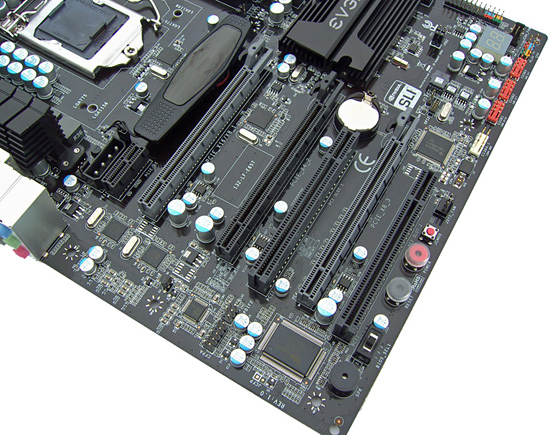
Looking over the slot layout; we have one PCIe 2.0 x1 slot, two PCI slots, and three PCIe 2.0 x16 slots providing x16/x4 or x8/x8/x4 lane allocation (depending upon usage). Seven (1 CPU + 6 additional) fully controllable fan headers are placed in various locations, five of which are easily accessible at all times regardless of component loading.
Onboard power, reset and CMOS clear buttons are placed at the lower edge of the board for those of us that like to test and use boards on an open testbed (the reset button doubles up as a flashing LED to show SATA activity).
That about rounds up today's quick preview, the official release is not far off so please bear with us...
















54 Comments
View All Comments
CK804 - Tuesday, August 11, 2009 - link
After I read your post, I thought about how most manufacturers still include floppy and IDE ports. I think this EVGA board is the first non-Intel branded motherboard I've seen that doesn't include floppy or IDE ports.Penzelbub2010 - Monday, August 10, 2009 - link
Well, yah it's a lot of money. But people buy these board because they appreciate their hardware. tehy want the best. Not all people are your Emachine, drop a buck and a half sail for a year or two Pc surfer. We get the hardest of hardware and push it till it can't be pushed anymore. I mean come on dude, we all need some sort of hobby, else we'd all be at the bar or some other debaucherous antic. I love buying hardware, specing it out, ordering it up, and yeah, one who follows this stuff, can get the deals and steals, and once yah get it, yah admore it, yah prey to the hardware gods that it'll kick like yah want it to, and wooolah, the need for speed is realized. Appearently, you must have a different hobby? Stamp collector maybe? what's a stamp collector doing reading Anandtech? lol.Ratman6161 - Wednesday, August 12, 2009 - link
But for those that feel that way there is the x58 and i7. Looks like I'll be sticking with 775 and my Q6600 for quite a while longer.dagamer34 - Tuesday, August 11, 2009 - link
What limits are being pushed? Give me facts, not sensationalism. What does "the best" have over "more bang for your buck"?Or for comparison, the equivalent question in CPU land would be what is the difference between $1000 Intel CPU and one of $500? And the response would be "a few megahertz and maybe some more L3 cache". I don't see what more a $250 mobo is adding when a $130 mobo would have overclock support, support for tons of USB ports and SATA channels, 7.1 audio, etc...
Rajinder Gill - Tuesday, August 11, 2009 - link
For someone using conventional cooling methods the differences betwween at $130 and $250 won't be worth the increased outlay.If sub-zero cooling is your thing (probably not in your case, but the FTW and Classified line from EVGA caters to this crowd), what we're seeing at the moment is the flexibility to change voltages during boot cycle time and being able to run lower overall CPU temperatures on one of our samples without the board locking up (the other vendor boards are topping out lower in some cases). The signal compensation adjustments allow slightly higher stable BCLK potential than the pother boards translating to higher benchmark scores in one way or another to those that care about such things. To some these little advantages are worth the extra. For the rest of us, there are plenty of products filling the $130-$200 bracket (including upcoming boards from EVGA (they have stuff coming in below $200), Gigiabyte, DFI the list goes on).
later
Hxx - Wednesday, August 12, 2009 - link
As it was said before, this board is not your conventional run of the mill best bang for the buck board. Given this and all other features bundled with this board, why don't they include a decent sound card, or a cheap high riser card that can be removed and replaced with a good one? Why is the sound component neglected on so many boards nowadays (especially the high end ones)?mindless1 - Thursday, August 20, 2009 - link
... because a high quality audio solution requires a lot of PCB real-estate, it simply wouldn't fit on a board unless it were designed to accomodate only mATX amount of slots/etc then the entire bottom devoted to the audio.Why they don't include an audio card is simple to understand, that anyone can buy the card/features they want and someone willing to spend the excessive amount of money on this board and the cost of sub-zero cooling needed to exploit the board's features, must be willing to throw a lot of money at their system so if audio is important to them another $100 or 2 wouldn't be much of a factor.
NA1NSXR - Tuesday, August 11, 2009 - link
That stamp collector probably has a faster system for less money and all he probably had to do was forego some clear windows, rainbow LEDs, and color coordinated mobo plastic.dagamer34 - Monday, August 10, 2009 - link
Can someone tell me why you would spend so much on a motherboard? I mean, from what I know, there are just lots of other things to spend money on that will get you higher performance. I know you that the bottom of the barrel stuff is missing some decent features, but what does the high-end stuff bring?Or maybe I'll have to wait for the review to find out...
Hapikern - Tuesday, August 11, 2009 - link
This motherboard is stupid, why someone would bother to buy this if you can get an X58 motherboard with equal or less money, P55 is supposed to be a mainstream aproach of the nehalem technology.